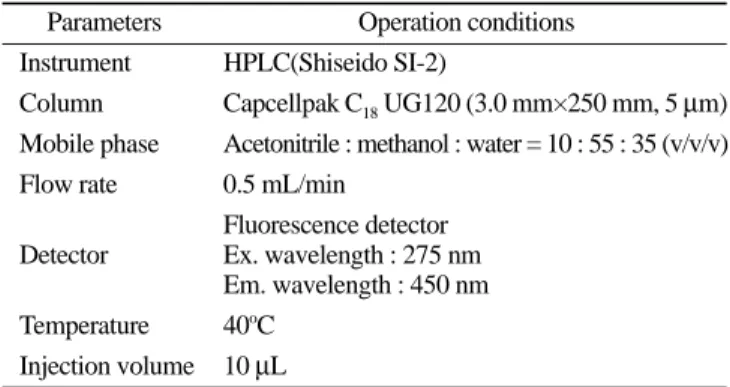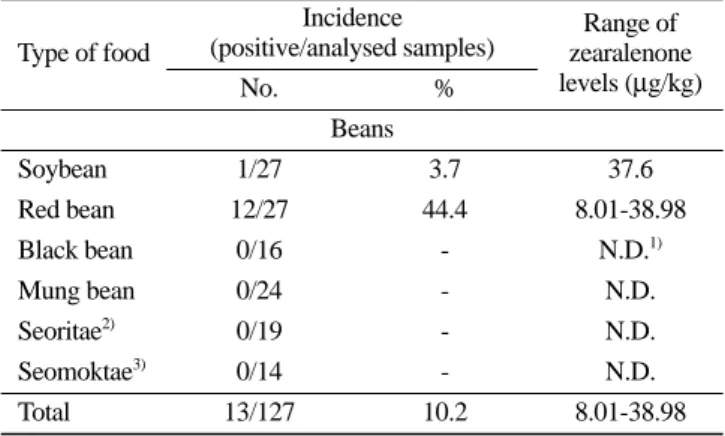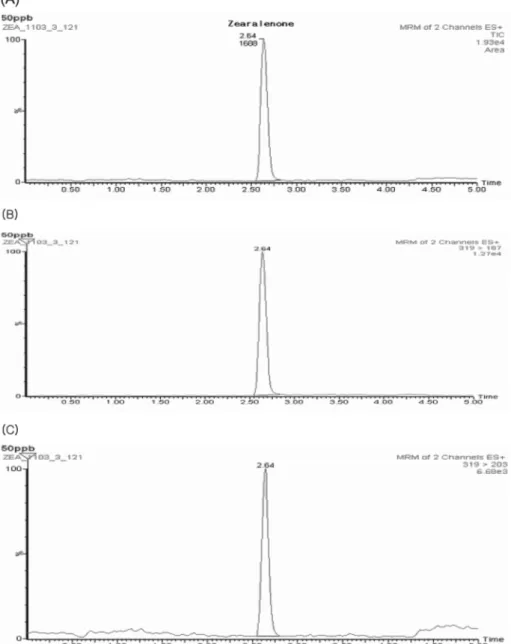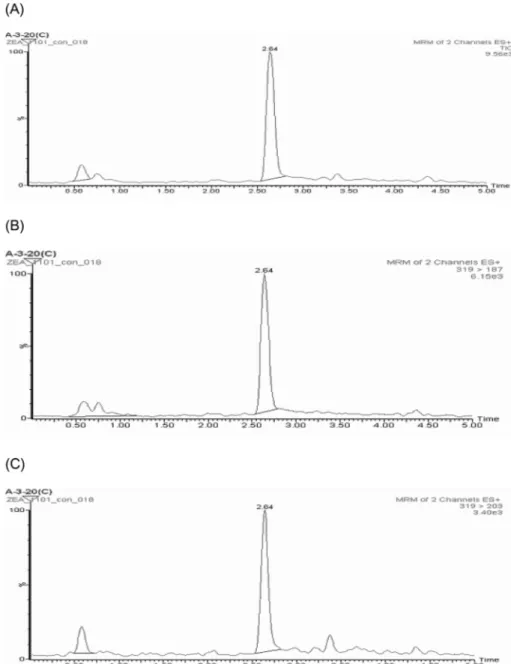354
©The Korean Society of Food Science and Technology
HPLC-FLD
및 LC-MS/MS에 의한 두류 중 제랄레논 오염실태 조사
장미란∗·이창희·이효정·김지연·손상혁·신춘식·김소희·김대병
부산지방식품의약품안전청 시험분석센터
A Survey of Zearalenone in Beans Using High Performance Liquid
Chromatography-Fluorescence Detector (HPLC-FLD) and Ultra
Performance Liquid Chromatography Tandem
Mass Spectrometry (LC-MS/MS)
Mi-Ran Jang∗, Chang-Hee Lee, Hyo-Jung Lee, Ji-Yeon Kim, Sang-Hyuk Son, Choon-Shik Shin, So-Hee Kim, and Dai-Byung Kim
Test & Analytical Center, Busan Regional KFDA
Abstract A survey for zearalenone contamination was conducted on 27 soy bean samples, 27 red bean samples, 16 black bean samples, 19 seoritae samples, 14 seomoktae samples, for a total of 127 commercial Korean samples. Zearalenone was quantified by the immunoaffinity column clean-up method with high performance liquid chromatography-fluorescence detection (HPLC-FLD), and was confirmed by liquid chromatography tandem mass spectrometry(LC-MS/MS). The limits of detection and quantification were 2.0µg/kg and 6.0 µg/kg, respectively. The recovery in the beans ranged from 82.2 to 98.4%. According to HPLC-FLD, zearalenone was detected in 13 samples (10.2% incidence), including 1 soybean and 12 red bean samples. The zearalenone contamination levels were in the range of 8.01~38.98µg/kg. Finally, LC-MS/MS analysis was conducted in the contaminated samples to verify the results of HPLC-FLD. The LC-MS/MS results confirmed the presence of zearalenone in all 13 samples. The contamination level was lower than that of EU, which is below 100 µg/kg for raw grains.
Key words: mycotoxin, zearalenone, immunoaffinity column, beans
서
론
제랄레논(zearalenone)은 Fusarium 속 곰팡이가 생성하는 독소 로 Fusarium graminaearum, Fusarium moniliforme 등에 의해 주 로 생성되며 비교적 열에 안정하여 조리, 가공 후에도 분해되지 않는다(1). 체내에 흡수되어 대부분 배출되나 일부는 자궁, 고환, 난소 등에 전달되어 과에스트로겐증, 유산, 불임 등 생식에 관련 된 독성을 주로 유발하는 것으로 알려져 있다(2-4). 전 세계적으 로 발생 빈도가 높은 곰팡이독소인 아플라톡신은 주로 열대 및 아열대 지역에서 발견되는데 비해 제랄레논은 5-20oC의 저온, 저 산소의 환경인 온대 및 한대지역에서 생산되는 농산물에서 흔히 발생되므로(5) 온대지역에 해당되는 우리나라, 미국, 유럽, 아시 아와 같은 지역에서 생산된 농산물은 Aspergillus 속 곰팡이 독소 보다는 Fusarium 곰팡이 독소에 오염될 가능성이 높을 것으로 예 상된다. 덴마크에서는 1998년부터 2001년 사이에 수확된 밀, 보리 및 호밀을 분석한 결과 시료 20%에서 제랄레논이 검출되었고(6), 독 일에서는 콩제품을 분석한 결과 제랄레논이 최고 214 µg/kg 수준 으로 검출되었으며 옥수수에서 85%(48 µg/kg)의 시료에서 검출되 었다는 국외 연구가 보고된 바 있다(7). 국내에서는 Kim 등(8)이 보리에서 287 µg/kg 검출사례를 보고하였고 Hyun 등(9)은 옥수 수, 보리, 밀가루 등을 분석한 결과 옥수수에서 최고 174.9 µg/kg 검출되었다고 보고한 바 있지만 대부분 시료가 보리, 옥수수, 밀 등 곡류에 제한적으로 모니터링 됨으로 전반적인 농산물에 대한 오염실태조사가 많이 부족한 실정이다. 제랄레논에 대한 기준이 설정되어 있는 유럽연합은 가공되지 않은 곡류에 대하여 100 µg/kg, 가공되지 않은 옥수수는 200 µg/ kg으로 규격 관리하고 있으며, JECFA(The Joint FAO/WHO Expert Committee on Food Additives)에서는 가장 민감한 동물인 돼지를 대상으로 수행한 15일간 실험결과의 무독성용량인 40 µg/kg body
weight를 바탕으로 종간, 개체간 불확실성 차이를 반영하여 잠정적
최대 허용 일일 섭취량(provisional maximum tolerable daily intake, PMTDI)을 0.5 µg/kg body weight/day로, 유럽식품과학위원회(EU scientific committee for food)에서는 0.2 µg/kg body weight/day으 로 제안하였다(10,11).
제랄레논의 분석방법은 thin layer chromatography(TLC)법(12), enzyme linked immuno sorbent assay(ELISA)(13), gas chroma-tography(GC), gas chromatography mass spectrometer(GC-MS) (14) 및 high performance liquid chromatography(HPLC), high performance liquid chromatography mass spectrometry(HPLC-MS) *Corresponding author: Mi-Ran Jang, Hazard Substances Analysis
Team, Test & Analytical Center, Busan Regional Korea Food & Drug Administration, Busan 608-829, Korea
Tel: 82-51-610-6221 Fax: 82-51-610-6199 E-mail: jmr97@hanmail.net
Received March 12, 2008; revised May 26, 2008; accepted May 31, 2008
(15,16,17)를 사용하는 방법이 알려져 있으며 정제법은 multifunc-tional column을 이용하거나 Sep-Pak silica cartridge를 이용한 방 법이 사용되어 왔으나 최근 들어 immunoaffinity column(IACs)을 이용한 신속하고 간편한 정제법이 제시되고 있다(17). 곰팡이독 소는 식품에 ppm 또는 ppb로 미량 존재하기 때문에 정제, 농축 및 고감도의 장비가 요구되어져 형광검출기를 장착한 HPLC와 IACs를 이용한 연구보고도 많이 제시되고 있다(1,17). 따라서 본 연구에서는 대두, 붉은콩, 검정콩, 녹두 등 두류에 대하여 immunoaffinity column으로 정제 후 HPLC fluorescence detection(HPLC-FLD)로 분석하는 방법을 이용하여 제랄레논에 대 한 오염실태를 조사하고 또한 제랄레논이 검출된 시료에 대하여 LC-MS/MS로 확인하고자 하였다.
재료
및
방법
실험재료 2007년 4월부터 9월까지 시중 유통 농산물 중 대두, 붉은콩, 검은콩, 녹두, 서리태(속청), 서목태(약콩) 6품목을 서울, 부산, 대 전, 대구 등 전국 대도시를 비롯하여 10개 지역의 대형 할인마 트, 재래시장 등에서 수집하였다. 대두 27건, 붉은콩 27건, 검정 콩 16건, 녹두 24건, 서리태 19건, 서목태 14건 총 127건 시료에 대하여 제랄레논 오염실태를 조사하였다. 모든 시료는 포장단위 (500 g~1 kg) 전체를 분쇄기로 균질화하여 −20oC 냉동상태로 보 관하면서 사용하였다. 시약 및 표준물질제랄레논 표준품은 Sigma Chemical Co.(St Louis, MO, USA)에 서 구입하였으며 추출 및 분석에 사용되는 acetonitrile, methanol은 HPLC 용으로 Merck Co.(Darmstadt, Germany) 제품을 사용하였 다. Sodium chloride(Merck Co.), n-hexane(Merck Co.) 등 분석 사 용된 모든 시약 및 용매는 특급 및 그 이상의 수준으로 사용하였다. 표준용액 조제 표준품을 methanol에 녹여 2,500 µg/mL 농도로 조제한 다음 75% methanol로 최종 농도가 5 ng/mL, 10 ng/mL, 25 ng/mL, 50 ng/mL, 75 ng/mL, 100 ng/mL가 되도록 희석하여 검량선용 표준용 액으로 하였다. 정제용 칼럼 및 분석장비
실험에 사용된 제랄레논 정제 immunoaffinity column은 zearala test(Vicam, Watertown, MA, USA)을 이용하였다. 이 칼럼은 1 mL syringe에 제랄레논 특이성을 지닌 monoclonal antibody가 부착된 sepharose가 충진된 것으로 완충액이 채워져 있으며 사용 유효기 간은 실온에서 1년이다. 분석장비는 고속액체크로마토그래피(HPLC Shiseido SI-2, Tokyo, Japan) 및 ultra performance liquid chro-matograhy(UPLC) ACQUITYTM
/Micromass Quattro Premier XE API triple-quadrupole mass spectrometer(UPLC-MS/MS, Micro-mass, Manchester, UK)를 사용하였다.
Table 1. HPLC conditions for the determination of zearalenone in beans
Parameters Operation conditions Instrument HPLC(Shiseido SI-2)
Column Capcellpak C18 UG120 (3.0 mm×250 mm, 5 µm)
Mobile phase Acetonitrile : methanol : water = 10 : 55 : 35 (v/v/v) Flow rate 0.5 mL/min
Detector Fluorescence detector Ex. wavelength : 275 nm Em. wavelength : 450 nm Temperature 40o C Injection volume 10 µL
Table 2. LC-MS/MS conditions for the confirmation of zearalenone
Instrument Parameter Condition
Liquid chromatography (Waters, ACQUITY UPLC)
Column ACQUITY UPLC
TH BEH C 18
(Waters, 2.1 mm×50 mm, 1.7mm) Mobile phase Solvent A(80) : 0.1% Formic acid in distilled water
Solvent B(20) : 0.1% Formic acid in acetonitrile
Flow rate 0.25 mL/min
Injection volume 10 µL
MS/MS (Waters, Micromass Quattro Premier XE)
Ionization mode ESI+
Capillary (kV) 3.5 Source temp. (o C) 120 Desolvation temp. (o C) 400 LM/HM resolution 14.0 / 14.0 Ion energy 1.0 Entrance/ Exit 1 / 1 MRM mode Precursor ion (m/z) 319
Product ion (m/z) 319>203 (Quantification)
319>185 (Confirmation)
Dwell time (s) 0.1
Con voltage (V) 22
시험용액 전처리
균질화한 시료 25 g에 sodium chloride 2 g 및 75% methanol 100 mL를 가하여 20분간 진탕 혼합한 다음 여과지(Adantec No.4) 로 여과하고 여액 10 mL에 증류수 20 mL을 혼합하였다. 이 때 혼합액이 현탁할 경우 원심분리(6,000 rpm, 10 min)한 다음 상등 액을 사용하였다. 시료 정제를 위해 혼합액 15 mL를 immunoaf-finity column으로 로딩(유출 속도를 초당 1-2방울을 초과하지 않 도록 함)한 후 증류수 15 mL로 씻고 methanol 5 mL로 제랄레논 을 용출시킨 다음 3 mL 공기를 통과시켜 column에 남은 액을 모 두 용출시킨 액을 모아 질소가스(40o C, 수욕상)로 농축시켰다. 이 를 이동상 용매 1 mL로 녹인 다음 0.45 µm membrane filter를 통 과시켜 HPLC용 및 UPLC-MS/MS용 시험용액으로 사용하였다. HPLC 및 LC-MS/MS 분석조건
제랄레논 정량분석을 위해 3023 pump, 3023 auto injector 그리 고 fluorescence detector(excitation 275 nm, emission 450 nm)가 장착된 Shiseido SI-2 시스템을 사용하였다. 칼럼은 capcellpak C18
UG120, 이동상은 acetonitrile:methanol:water(10:55:35, v/v/v) 사용 하였다(Table 1). 또한 HPLC-FLD로 제랄레논 오염이 확인된 시 료는 LC-MS/MS(UPLC ACQUITYTM
/Micromass Quattro Premier XE API triple-quadrupole mass spectrometer(Micromass, Manches-ter, UK)를 사용하여 Table 2에 제시된 조건으로 분석하였다.
결과
및
고찰
검량선, 검출한계 및 정량한계 표준용액을 5 ng/mL, 10 ng/mL, 25 ng/mL, 50 ng/mL, 75 ng/ mL, 100 ng/mL 농도로 조제하여 검량선을 구한 결과 상관계수 (R2 )는 0.9998로 양호한 직선성을 나타내었고 검출한계(limit of detection)는 signal 대 noise 비가 3대 1일 때의 농도, 정량한계 (limit of quantification)는 LOD ×3일 때의 농도로 구한 결과, 각 각 2 µg/kg, 6 µg/kg이었다. Urraca 등(15)에 따르면 검출한계가 3-6µg/kg, Mateo 등(17)은 4 µg/kg, Jimenez 등(20)은 3 µg/kg로 다 른 연구자의 결과 보다 낮은 검출한계를 보였다. 회수율 및 재현성 제랄레논이 오염되지 않은 검은콩, 붉은콩에 최종농도가 각각 5µg/kg, 10 µg/kg, 25 µg/kg, 50 µg/kg, 75 µg/kg 그리고 100 µg/kg 이 되게 제랄레논 표준용액(0.1 µg/mL, 0.5 µg/mL, 50 µg/mL, 250 µg/mL, 500 µg/mL)을 첨가하여 각 시료에 대한 회수율을 검토한 결과, 검정콩 85.2-98.4%, 붉은콩 82.2-91.6%로 양호한 회수율을 보였다. 또한 동일 조건에서 1일 5회 반복 실험하여 재현성을 검 토한 결과 RSD가 검정콩, 붉은콩에서 각각 1.45-5.97%, 0.82-6.40%로 비교적 양호한 재현성을 보였다(Table 3). 시료 중 제랄레논 오염도조사 식품 중 미량 존재하는 제랄레논을 분석하기 위하여 시중 유 통되는 농산물 중 대두, 붉은콩, 검은콩, 녹두, 서리태(속청), 서 목태(약콩)을 대상으로 총127건 수집하여 오염도를 조사한 결과, 대두(백태) 27건 중 1건(3.7%)에서 37.62 µg/kg 검출되었고 붉은 콩(팥) 27건 중 12건 검출되어 44.4%의 검출율을 보였고 그 오 염수준은 8.01-38.98 µg/kg이었다. 나머지 시료 검정콩 16건, 녹두 24건, 서리태(속청) 19건, 서목태(약콩) 14건에서는 모두 검출되지 않았다(Table 4). 따라서 전체 시료 127건 중 13건 검출되어 10.2%의 검출율을 보였고 그 오염수준은 8.01-38.98 µg/kg이었다. 제랄레논 표준용액 및 검출된 붉은콩의 HPLC-FLD 크로마토그 램을 Fig. 1, 2로 나타냈다. 본 연구결과에서 검출된 제랄레논의 오염수준은 기준이 설정되어 있는 유럽연합(가공되지 않은 곡류 :100µg/kg, 가공되지 않은 옥수수:200 µg/kg)의 기준을 초과하는 것은 없는 것으로 나타났다. 두류에 대한 연구보고를 살펴보면 캐나다 Scott 등(19)은 대두 97건 중 6건에서 5-39 µg/kg 검출되 었다고 보고하였고 독일 Schollenberger 등(20-22)은 콩 5건 중 1 건에서 7 µg/kg, 콩식품 45건 중 7건에서 2-214 µg/kg, 대두유 14 건 중 3건에서 5-46 µg/kg 검출되었다고 보고하였다. 대두의 경우 캐나다의 오염수준과 유사하였고 독일 가공식품인 Soya meal, 대 두유에 비해 오염수준이 비교적 낮았다. 본 연구에서 검출율이 가장 높게 나타난 붉은콩는 독일 콩식품에 비해 오염수준이 비 슷하거나 낮은 경향을 보였다. 하지만 동 시료의 경우 연구보고 가 극히 미비하여 국내외 다른 연구 결과와 직접적 비교는 어려 우나, 제랄레논 곰팡이독소에 오염될 가능성이 높아 지속적으로 연구된 옥수수, 보리를 대상으로 그 오염수준을 비교한 결과, 독 일(보리:2-311 µg/kg, 옥수수:860 µg/kg이하)(23,24), 캐나다(보리:4-21µg/kg, 옥수수:5-647 µg/kg)(19) 그리고 한국 박 등(보리:14-171 µg/kg, 옥수수가공품:36-84 µg/kg)(25) 및 전 등(보리:33.3 µg/kg, 옥 수수:평균 42.8 µg/kg, 최대 174.9 µg/kg)(26)의 오염수준과 유사하 거나 낮은 수준이었다. 모니터링 결과가 유럽연합 기준 이하로 안전한 수준으로 검토되었으나 곰팡이독소는 기후, 수확 전 후 관 리, 저장, 유통 등의 여러 요인에 영향을 받기 때문에 동일한 시 료라도 오염수준이 달리 나타날 수 있어 정확한 노출평가를 위해 서는 지속적인 모니터링이 필요하다고 사료되며 앞으로도 우리나 라는 free trade agreement(FTA)와 같은 무역협정으로 인하여 외Table 3. Recoveries (n=5) of zearalenone from black bean and red bean spiked with standard solution at the levels of 0.1, 0.5,
1.0, 5.0, and 10.0 µg/mL, respectively Spiked level (µg/mL) Measured level (µg/kg) Recoveries (%) ± RSD (%) Black bean Red bean
0.1 5 97.2 ± 1.46 88.7 ± 6.40
0.5 25 85.2 ± 1.69 82.2 ± 1.89
1.0 50 88.1 ± 5.97 85.7 ± 0.82
5.0 250 98.4 ± 4.11 89.7 ± 1.75
10.0 500 95.8 ± 1.45 91.6 ± 1.64
Table 4. The incidence and levels of zearalenone in various beans by HPLC/FLD Type of food Incidence (positive/analysed samples) Range of zearalenone levels (µg/kg) No. % Beans Soybean 1/27 3.7 37.6 Red bean 12/27 44.4 8.01-38.98 Black bean 0/16 - N.D.1) Mung bean 0/24 - N.D. Seoritae2) 0/19 - N.D. Seomoktae3) 0/14 - N.D. Total 13/127 10.2 8.01-38.98 1)N.D. : Not detected 2)Glycine max merrill 3)Rhynchosia nolubilis
Fig. 1. HPLC/FLD chromatogram of zearalenone standard at 50µg/kg.
Fig. 2. HPLC/FLD chromatogram of a positive red bean sample
was detected zearalenone at 38.98µg/kg.
Fig. 3. LC-MS/MS chromatograms of zearalenone standard at 50µg/kg. (A) Total ion current (TIC) chromatogram of standard, (B) MRM
국 농산물의 수입이 늘어날 것으로 예상되어 식품 안전성확보를 위해 동 곰팡이독소에 대하여 광범위하게 오염실태 조사가 되어 야 한다고 생각된다(27-29).
LC/MS/MS을 이용한 검출시료 확인
HPLC/FLD에서 검출된 시료를 LC/MS/MS를 이용하여 확인한 결과 product ion인 185 m/z, 203 m/z을 얻어서 MRM(multiple reaction monitoring) mode로 분석하여 대두 1건, 붉은콩 12건에서 product ion 185 m/z, 203 m/z을 확인하였다. 검출 시료 13건 모 두 제랄레논임을 확인하였고 제랄레논의 표준용액 및 검출시료 에 대한 LC/MS/MS 크로마토그램은 Fig. 3, 4로 나타냈다.
요
약
국내유통 중인 대두, 붉은콩, 검은콩 녹두 등 6품목의 두류 총 127건을 immunoaffinity column 정제방법 및 HPLC-FLD을 이용 하여 제랄레논에 대한 오염실태를 조사하였다. 상관계수(R2 ) 0.999 이상으로 양호한 직선성을 보였고 검출한계 및 정량한계는 각각 2.0µg/kg, 6.0 µg/kg, 회수율 82.2-98.4%로 나타났다. RSD가 0.82-6.40%로 양호한 재현성을 나타내었다. 모니터링 결과, 대두(백태) 27건 중 1건(3.7%)에서 37.62 µg/kg 검출되었고 붉은콩(팥) 27건 중 12건 검출되어 44.4%의 검출율을 보였고 그 오염수준은 8.01-38.98µg/kg이었다. 나머지 시료 검정콩 16건, 녹두 24건, 서리태 (속청) 19건, 서목태(약콩) 14건에서는 모두 검출되지 않았다. 따 라서 총 시료 127건 중 13건 검출되어 10.2%의 검출율을 보였 고 그 오염수준은 8.01-38.98 µg/kg이었다, 검출시료 13건을 LC-MS/MS로 확인한 결과 모두 제랄레논임이 확인되었다. 본 연구 결과에서 나타난 두류의 검출빈도 및 오염수준은 유럽연합에서 설정된 기준규격 이하의 수준이었으나 곰팡이독소의 생성의 특 이성을 고려한다면 지속적이고 광범위하게 오염실태 조사가 되Fig. 4. LC/MS/MS chromatogram of contaminated red bean. (A) Total ion current (TIC) chromatogram of red bean (B), MRM
어야 한다고 판단된다.
문
헌
1. Martins ML, Marins HM. Influence of water activity, temperature and incubation time on the simultaneous production of deoxyni-valenol and zearalenone in corn (Zea mays) by Fusarium
graminearum. Food Chem. 79: 315-318 (2002)
2. D'Mello JPF, Placinta CM, Macdonald AMC. Fusarium mycotox-ins-a review of global implications for animal health, welfare, and productivity. Anim. Feed Sci. Tech. 80: 183-205 (1999) 3. Cole RJ, Cox RH. Handbook of TFM. Academic Press, NY,
USA. pp. 152-263 (1981)
4. Ito Y, Ohtsuo KI. Effects of neonatal administration of zearale-none on the reproductive physiology of female mice. J. Vet. Med. Sci. 56: 1155-1159 (1994)
5. Kamimura H. Problems with mycotoxin in food sanitation. Hyogo International Center, Japan International Cooperation Agency, Japan. pp. 10-26 (1993)
6. Rasmussen PH, Ghorbani F, Berg T. Deoxynivalenol and other
Fusarium toxins in wheat and rye flours on the Danish market.
Food Addit. Contam. 20: 396-404 (2003)
7. Schollenberger M, MLler HM, Rfle M, Terry-Jara H, Suchy S, Plank S, Drochner W. Natural occurrence of Fusarium toxins in soy food marketed in Germany. Int. J. Food Microbiol. 113: 142-146 (2007)
8. Kim JC, Kang HJ, Lee DH, Lee YW, Yoshizawa T. Natural occur-rence of Fusarium mycotoxins (Trichothecences and Zearalenone) in barley and corn in Korea. Appl. Environ. Microbiol. 59: 3798-3802 (1993)
9. Hyun EO, Hyun JC, Sung WC, Nari L, Hyun JK, Min SK, Hyang SC. Co-occurrence of deoxynivalenol and zearalenone in cereals and their products, J. Food Hyg. Saf. 22: 375-381 (2007) 10. European Mycotoxins Awareness Network. Maximum levels for
certain contaminants in foodstuffs (1), Commission Regulation (EC) No 1881/2006. Available at: http://services. leatherheadfood. com/mycotoxins. Accessed Mar. 17, 2008.
11. FAO Worldwide regulations for mycotoxins in food and feed in 2003, FAO Food and Nutrition Paper 81. Available at : http://www. fao.org/docrep/007/y5499e/y5499e00. htm. Accessed Mar. 2, 2008. 12. Gimeno A. Rapid thin layer chromatographic determination of
zearalenone in corn, sorghum, and wheat. J. Assoc. Off. Anal. Chem. 66: 565 (1983)
13. Kang SJ, Chung DH. Establishment of indirect competitive ELISA for the detection of zearalenone produced by Fusarium
sp. J. Food Hyg. Saf. 13: 419-424 (1998)
14. Scott PM, Kanhere SR, Weber D. Analysis of Canadian and imported beers for Fusarium mycotoxins by gas chromatography-mass spectrometry. Food Addit. Contam. 10: 381-389 (1993) 15. Urraca JL, Marazuela MD, Moreno-Bondi MC. Analysis for
zearalenone and α-zearalenol in cereals and swine feed using
accelerated solvent extraction and liquid chromatography with fluorescence detection. Anal. Chim. Acta 524: 175-183 (2004) 16. Peter Z, Bernhard MH. Trace mycotoxin analysis in complex
bio-logical and food matrices by liquid chromatography-atmospheric pressure ionization mass spectrometry. J. Chromatogram. 1136: 123-169 (2006)
17. Mateo JJ, Mateo R, Hinojo MJ, Llorens A, Jimenez M. Liquid chromatographic determination of toxigenic secondary metabolites producted by Fusarium strains. J. Chromatogram. 955: 245-256 (2002)
18. Jimenez M, Mateo R. Determination of mycotoxins produced by
Fusarium isolated from banana fruits by capillary gas
chromatog-raphy and high performance liquid chromatogchromatog-raphy. J. Chromato-gram. 778: 363-372 (1997)
19. Scott PM. Multi-year monitoring of Canadian grains and grain-based foods for trichothecenes and zearalenone. Food Addit. Con-tam. 14: 333-339 (1997)
20. Schollenberger M, Muller HM, Rufle M, Suchy S, Planck S, Drochner W. Survey of Fusarium toxins in foodstuffs of plant origin marketed in Germany. Int. J. Food Microbiol. 97: 317-326 (2005)
21. Schollenberger M, Muller HM, Rufle M, Terry-Jara H, Suchy S, Planck S, Plank S, Drochner W. Natural Occurrence of Fusarium toxins in soy food marketed in Germany. Int. J. Food Microbiol. 113: 142-146 (2007)
22. Schollenberger M, Muller HM, Rufle M, Drochner W. Natural Occurrence of 16 Fusarium toxins in edible oil marketed in Ger-many. Food Control 19: 475-482 (2008)
23. Schollenberger M, Muller HM, Rufle M. Natural occurrence of 16 Fusarium toxins in grains and feedstuffs of plant origin from Germany. Mycopathologia 161: 43-52 (2006)
24. Muller HM, Reimann J, Schumacher U, Schwadorf K. Natural occurrence of Fusarium toxins in barley harvested during five years in an area of southwest Germany. Mycophthologia 137: 185-192 (1997)
25. Park JW, Kim EK, Shon DH, Kim YB. Natural co-occurrence of aflatoxins B1, fumonisin B1, and ochratoxin A in barley and corn foods from Korea. Food Addit. Contam. 19: 1073-1080 (2002) 26. Ok He, Chang HJ, Choi SW, Lee N, Kim HJ, Koo MS, Chun
HS. Co-occurrence of deoxynivalenol and zearalenone in cereals and their products. J. Food Hyg. Saf. 22: 375-381 (2007)
27. Song HH, Kim J, Lee C. A review of mycotoxins from Fusarium species. Safe Food 1: 19-28 (2006)
28. Magan N, Olsen M. Mycotoxin in Food Detection and Control. Woodheard Publishing Limited, Abington, Cambridge, England. pp. 353-366 (2004)
29. JECFA Joint FAO/WHO Expert Committee on Food Additives, 53rd Report. Safety evaluation of certain food additives. WHO
Food Additives Series 44, Zearalenone (2000). Available at : http:// www.inchem.org/documents/jecfa/jecmono/v44jec14. htm. Accessed Jan. 31, 2008.



